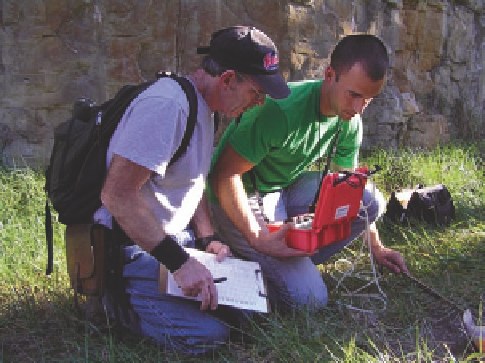Geology Reference
In-Depth Information
Figure 9.2.11. Pitot instrumentation (tube and flow meter (red box)) used for measuring the velocity of coal-fire
gas exhaled from vents at the surface. This instrument is a product of FlowKinetics LLC, 528 Helena Street, Bryan,
Texas 77801, USA. Photo by Jennifer M.K. O
'
Keefe, 2009.
conjunction with a flow meter, such as the Flow Kinetics FKT 1DP1A-SV, which contains pressure transducers
used to measure the pressure differential, as well as absolute pressure, temperature, and relative humidity. By
collecting multiple measurements for each of these parameters at a coal-fire gas vent, the mass flow, volume flow,
and variability in flow can be quickly assessed. This information is critical for estimating gas flow rates from coal-
fires vents.
Discussion
T
he procedures described above for collecting coal-fire gas and minerals were successfully field tested and a
number of analyses obtained for fires in SW Colorado, Indonesia, and the Wuda coal field, Inner Mongolia
autonomous region of northern China. Work with samples from Centralia will soon begin. All results will
be published in forthcoming chapters along with pressure
temperature stability diagrams. One such diagram
(Figure 9.2.12) was derived by Stracher (1995) for the condensation of orthorhombic sulfur from anthracite gas
-
P
S
2
(g)
-
T
Stability diagram: condensation of
orthorhombic sulfur from anthracite coal gas
0
-2
Orthorhombic
sulfur
-4
-6
Sulfur gas
S
2
(g)
-8
-10
-12
-14
-16
200
300
400
500
600
Temperature (K)
Figure 9.2.12. Pressure
temperature stability diagram for the condensation of orthorhombic sulfur from anthracite
gas, Centralia mine fire, Pennsylvania. From Stracher, 1995.
-
































